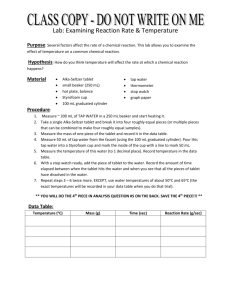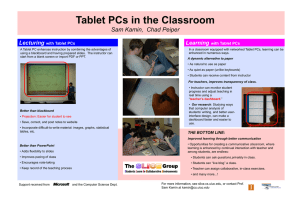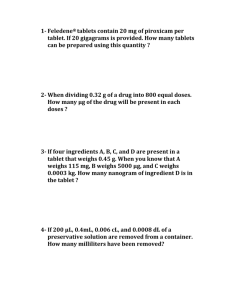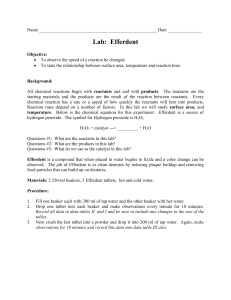Pain and Muscle Activity of Neck, Shoulder and Forearm Muscles
advertisement
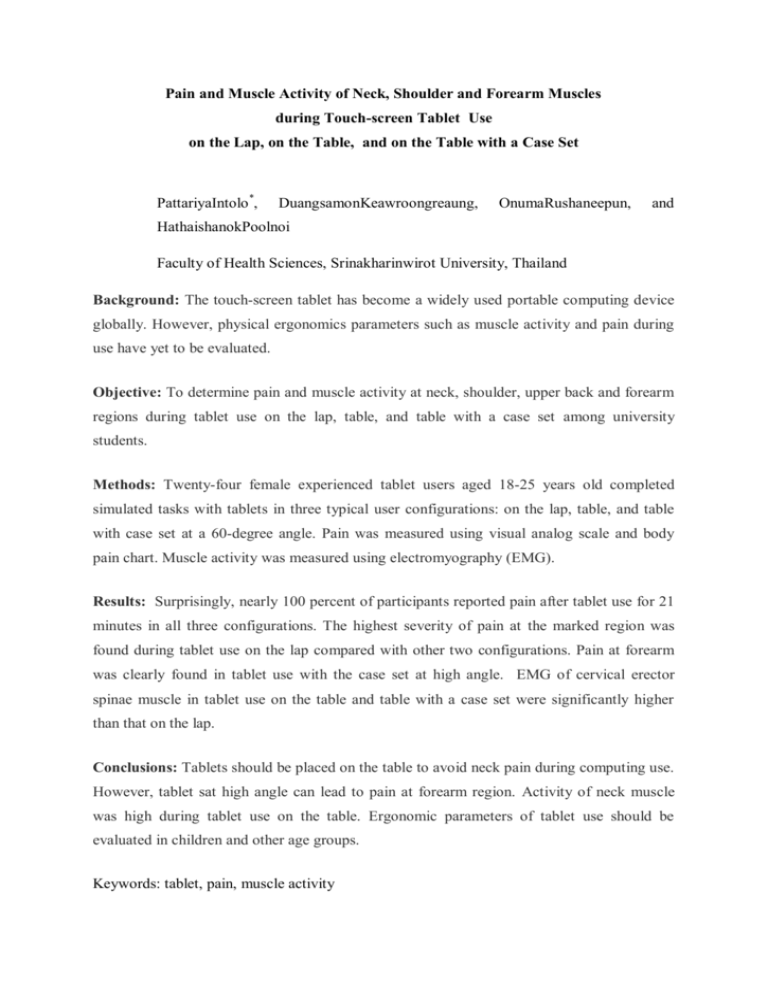
Pain and Muscle Activity of Neck, Shoulder and Forearm Muscles during Touch-screen Tablet Use on the Lap, on the Table, and on the Table with a Case Set PattariyaIntolo *, DuangsamonKeawroongreaung, OnumaRushaneepun, and HathaishanokPoolnoi Faculty of Health Sciences, Srinakharinwirot University, Thailand Background: The touch-screen tablet has become a widely used portable computing device globally. However, physical ergonomics parameters such as muscle activity and pain during use have yet to be evaluated. Objective: To determine pain and muscle activity at neck, shoulder, upper back and forearm regions during tablet use on the lap, table, and table with a case set among university students. Methods: Twenty-four female experienced tablet users aged 18-25 years old completed simulated tasks with tablets in three typical user configurations: on the lap, table, and table with case set at a 60-degree angle. Pain was measured using visual analog scale and body pain chart. Muscle activity was measured using electromyography (EMG). Results: Surprisingly, nearly 100 percent of participants reported pain after tablet use for 21 minutes in all three configurations. The highest severity of pain at the marked region was found during tablet use on the lap compared with other two configurations. Pain at forearm was clearly found in tablet use with the case set at high angle. EMG of cervical erector spinae muscle in tablet use on the table and table with a case set were significantly higher than that on the lap. Conclusions: Tablets should be placed on the table to avoid neck pain during computing use. However, tablet sat high angle can lead to pain at forearm region. Activity of neck muscle was high during tablet use on the table. Ergonomic parameters of tablet use should be evaluated in children and other age groups. Keywords: tablet, pain, muscle activity * Corresponding Author:DrPattariyaIntolo PT, Ph.D. (Physiotherapy) Faculty of Health Sciences, Srinakharinwirot University, Ongkharak, Nakhon-Nayok, 26120, Thailand Phone: (+66) 84944 5859 Fax: (+66) 37 395438 E-mail: pattariy@swu.ac.th 1 Introduction Tablet computers have recently become very popular in the global computer market with increases of U.S. Internet users owned a tablet from 12% in 2011 to 31% in 2013 (Moscaritolo, 2013). The mobility properties and easy to use touch-screen of a tablet are the main reasons behind this trend. However, such properties allow the user to adopt a variety of postures leading to health problems. In addition, the keyboard and displays are included in a small screen compared to laptop and desktop computers which also leads to health problems. Risk of musculoskeletal symptoms in computer users may relate to display position and location of computer during usage. Pain at neck and shoulder were reported arising from computer use among users (Bongers et al, 2006, Brandt et al, 2004, Hakala et al, 2006, Janwantanakul et al, 2008, Siu e tal, 2009, Godl et al, 2011,). Positioning of computer and location of display as relates to pain and muscle activity at neck and shoulder has been widely examined (Psihogios et al, 2001, Siu et al, 2009, Straker et al, 2008, Gold et al, 2011, Young et al, 2012).Increase in head neck flexion moment and cervical erector spinae muscle group activity were found in lower display position (Villanueva et al., 1996, Turville et al, 1998, Sommerich et al., 2001, Greig, Straker, & Briggs, 2005). Tablets were used in a wide variety of locations including on the lap, table, on a case to set it at any angle, and holding it (Young et al, 2012). Guidelines for good ergonomics for tablet use –following investigations into physical ergonomic parameters and neck and shoulder pain– need to be established urgently due to increasing usage. Interestingly, pain and muscle activity at forearm region during tablet use has not yet been evaluated even though it is active with a touch-display, differing from PC and laptop computers. The study aimed to evaluate the severity and location of pain and muscle activity at the neck, upper trunk, shoulder and forearm regions after tablet use emailing, typing and game playing for 21 minutes in three workstations, namely, on the lap, table and table with a case set among university students aged 18-25 years old. 2 Methods Study design A within-participant design was used to examine the effect of three tablet workstations on neck, and upper limb pain and muscle activity. Participants Females aged 18-25 years old were recruited into the current study (Table 1). The participants used tablets twice a week for at least 2 hours per week. The exclusion criteria included any history of pain at neck, shoulder and upper limb regions requiring clinical treatment. All participants were right-hand dominant and had normal or corrected-to-normal vision. The present study was approved by the Human Ethics Committee of Health Science Faculty, Srinakarinwirot University. Table 1 Anthropometric values for 24 female participants. Participants Age Mean Standard Range Height Body mass index Body height (kg/m2) (yr) (cm) 21.2 160.6 20.5 84.88 5.7 1.5 7.19 18-23 73-93 1 18-25 150-175 (cm) Independent Variables The position of tablet (size 9.5x7.3x0.4 inches) use was observed in university students representing the three workstations of on the lap, table and table with a case set (Figure 1). Participants sat on a standard chair and table commonly used in the university with no adjustment of height and tilt. The location of tablet was placed directly in front of participants2 inches from the edge of the table; this location was generally observed in this group of students. In the laboratory, climate and light was controlled. Figure 1 Three workstations a) on the lap b) on the table c) on the table with a case set at 60degree tilt Tasks The three tasks were: 1) internet searching and e-mail reading, 2) game playing, 3) typing words; each task lasted7 minutes totaling21 minutes with a rest period between workstations. Dependent Variables Location and severity of pain were measured with visual analog scale and body pain chart (Mekhora et al, 2000). Level of pain was on a scale of 0-10 where 10 indicated extreme pain and 0 no pain. Pain was divided into four levels: no pain (VAS=0-0.04), mild pain (VAS=0.05-4.4), moderate pain (VAS=4.5-7.4), and severe pain (VAS=7.5-10) (Hawker et al, 2011). Surface electromyography was recorded from the right cervical erector spinae (CES), right upper trapezius (UT), right thoracic erector spinae/scapular retractors (TES), and right wrist extensor bundle (RWE). Pairs of 10-mm diameter Ag-AgCl disposable surface electrodes (Uni-Patch, Wasbasha, MN) were placed 25 mm apart (center to center) after the skin had been thoroughly prepared by shaving and cleaning. Location of surface electrode and amplitude normalization to maximal voluntary contraction (MVC) was performed (Straker et al, 2008). Raw EMG signals were collected via a four-channel AMT-8 EMG cable telemetry system(Bortec Biomedical, Alberta, Canada) with analogue differential amplifiers and sampled at 1000 Hz. Mean EMG activity over the last two minutes (20min-21 min) of each workstation was utilized for analysis. Procedure Participants completed an informed consent form. Instruction of required workstations and tasks was described. Maximum voluntary contraction of each muscle was collected. Participants performed tablet use in three workstations in random order with 21 minutes for each workstation and 15 minutes break between. Participants were asked to define location and severity of pain on the body pain chart and visual analog scale immediately after finishing tablet use in each workstation. Statistical Analysis The dependent variables were pain and muscle activity at the neck, shoulder, upper back and forearm regions. The independent variables were the three workstations of tablet use on the lap, table and table with a case set. Intensity of marked pain regions and overall pain intensity were calculated for the mean and standard deviation, and number of anatomical pain regions marked was counted. To examine mean differences in EMG for the three workstations, one-way ANOVA repeated measures with Bonferroni adjustment for alpha to account for multiple comparisons was used with alpha level of .05. 3 Results 3.1 Pain in three workstations of tablet use One hundred percent of participants(n=24/24) reported pain after emailing, playing computer games, and typing for tablet use on the lap, while approximately ninety six percent (n=23/24) reported pain in tablet use on the table and on the table with a case set (Table 1). Participants experienced pain at a mean of 3.3-3.5 for the four overall regions (neck, upper back, shoulder and forearm) after finishing tablet use in the three workstations. Average intensity of pain in the regions marked for tablet use on the lap was highest with a pain level of 4.4, while this was 3.1 and 2.5 for on the table and on the table with a case set, respectively. Average overall intensities after tablet use on the lap, table and table with a case set were 2.6, 1.9, and 1.6 respectively. Table 1 Body region of pain of tablet use in 3 workstations (n=24) Tablet use in Pain Number of Intensity Overall in any body part regions of region intensity 3 workstations marked Number of Mean (SD) Mean (SD) Mean (SD) participant (%) On the lap n=24 (100%) 3.5 (0.9) 4.4(2.2) 2.6 (1.5) On the table n=23 (96%) 3.5 (1.1) 3.1(2.0) 1.9 (1.4) On the table with a case set n=23 (96%) 3.3 (1.2) 2.5(1.9) 1.6 (1.5) Interestingly, there were two participants reporting severe pain at neck after tablet use on the lap, whereas there were no such participants for tablet use on the table and table with a case set. In addition, the number of participants reporting moderate pain at neck was highest when compared with the other two workstations (Figure 2). The number of participants experiencing mild pain at upper back was similar for tablet use on the table with case, on the table and on the lap at 16, 15 and 17 respectively. However, 4 participants reported moderate pain at upper back after tablet use on the table,2 after tablet use on the lap, and none after tablet use on the lap with a case set. The number of participants who experienced mild pain at shoulder after tablet use did not differ for the three workstations: on the lap (n=19), table (n=20) and table with a case set (n=19). Interestingly, moderate pain at forearm was reported by participants using tablets on the table with a case set, while there was only one report for on the table and none after tablet use on the lap. Pain at neck region Number of participant (n=24) 20 20 18 15 12 10 5 0 3 1 2 0 on the table with case no pain 10 mild 4 moderate 0 on the table 0 2 severe on the lap Workstations Figure 2 Pain at neck region after tablet use On the table with a case set, on the table and on the lap Table 2 Location of pain and severity of pain of tablet use in 3 workstations (n=24) Location of pain: Number of participants experiencing pain. Pain scale No pain (VAS =0-0.04) Neck : n=0 Upper back :n=5 Shoulder :n=2 Wrist : n=6 Neck :n=2 Upper back: n=5 Shoulder :n=2 Wrist : n=3 On the table with a case set Neck :n=3 Upper back: n=8 Shoulder :n=3 Wrist : n=5 Mild pain (VAS =0.05-4.4) Neck :n=12 Upper back: n=17 Shoulder :n=19 Wrist : n=18 Neck :n=18 Upper back: n=15 Shoulder :n=20 Wrist : n=20 Neck : n=20 Upper back: n=16 Shoulder :n=19 Wrist : n=17 Moderate pain (VAS =4.5-7.4) Neck :n=10 Upper back : n=2 Shoulder :n=3 Wrist : n=0 Neck :n=4 Upper back: n=4 Shoulder :n=2 Wrist : n=1 Neck :n=1 Upper back : n=0 Shoulder :n=2 Wrist : n=2 Neck :n=2 Upper back : n=0 Shoulder :n=0 Wrist :n=0 Neck :n=0 Upper back : n=0 Shoulder : n=0 Wrist : n=0 Neck: n=0 Upper back : n=0 Shoulder :n=0 Wrist : n=0 Severe pain (VAS =7.5-10) On the lap On the table Table 3EMG activity of 4 muscles of tablet use in 3 workstations (n=24) EMG Muscle activity (%Normalization) Muscles Workstations On the lap On the table 1. Wrist Extensor 15.47%± 11.08% 14.74%± 10.20% On the table With a case set 13.30% ± 5.91% 2. Cervical erector spine 11.02% ± 6.24% 26.45%± 16.82% 20.44% ± 9.34% 3. Upper trapezius 16.15%± 11.00% 21.01%± 17.81% 25.39%± 19.17% 4. scapular retractors 10.82% ± 7.55% 12.80% ± 8.40% 12.18% ± 8.10% P value No significant difference in all three workstations Significant difference Lap vs table (p<0.05) Lap vs table with a case set (p<0.05) No significant difference for table vs table with a case set No significant difference in all three workstations No significant difference in all three workstations Lap = tablet use on the lap, table = tablet use on the table, table with a case set = tablet use with a case set, vs = versus There was significant difference in EMG of cervical erector spinae between tablet use on the lap and the table with p value of 0.05; for between tablet use on the lap and the table with a case set this also stood at 0.05. However, there was no significant difference of EMG of cervical erector spinae between tablet use on the table and table with a case set. There was no significant difference for the other 3 muscles of wrist extensor, upper trapezius, and thoracic upper trapezius and scapular retractors after tablet use in the three workstations after 21 minutes. 4 Discussions The purpose of the current study was to assess pain and muscle activity at neck, upper trunk, shoulder and forearm after tablet use among university student for 21 minutes in three workstations: on the lap, on the table and on the table with a case set. The results showed that using tablets in different workstations affected various locations and severity of pain and level of muscle activity. Generally, pain in any body part of the user, particularly neck pain was reported in almost all participants after 21 minutes in all workstations. There was no significant difference between the muscle activities of upper trapezius, scapular retractor and forearm extensor muscles among all workstations; however, muscle activity of erector spinae in tablet use on the lap was significantly higher than that on the table and table with a case set. It was clear that every participant reported neck pain after using tablets on their laps for just21 minutes. In addition, intensity of pain in region marked and overall pain intensity during tablet use on the lap was higher than the other two workstations. Surprisingly, 2 participants reported severe neck pain and 10 moderate neck pain after tablet use on the lap for 21 minutes. This may be because the tablet was placed on the lap, which is much lower than eye level. Moreover, tablet screens are generally small when compared with laptops and desktops. To view the tablet screen properly, users need to be in a flexed neck posture, leading to neck pain. The current study supported previous findings that working with a low height screen leads to neck pain because of the flexed neck posture of the users (Gold et al, 2011). It is noteworthy that almost all participants reported pain in at least one area (neck, upper trunk, shoulder and forearm) following tablet use over a long period (21 minutes) on the lap, table, and table with a case set. A previous study supports this finding; spending longer time sitting on the computer leads to higher musculoskeletal pain (Jacob and Baker, 2002).The current study therefore suggests that frequent breaks be taken within in prolonged tablet usage to reduce the risk of musculoskeletal problems. This is the first study addressing the use of computer devices with touch screens and pain and muscle activity at forearm region. Even though muscle activity of wrist extensor did not significantly differ among all three workstations, tablet use on the table with a case set at 60 degrees clearly had a higher number of participants reporting moderate pain at forearm compared with the other two workstations. No participants reported moderate pain at the forearm after tablet use on the lap. Possibly, wrist posture was at a higher degree of extension while working at a tablet with a case set at 60 degrees compared with on the lap. Obviously, during tablet use, the wrist moves to the radial and ulnar sides while fingers move over a wide range on the screen and zoom in/out – differing from wrist movements in typing on keyboards and using mouses on desktops and laptops. Therefore, further study needs to evaluate the pain and muscle activity of the wrist in radial and ulnar directions and fingers while using tablets. Surprisingly, the study found that neck erector spinae in tablet use on the lap was significantly lower (p<0.05) than that on the table and table with case set. This may be because during tablet use on the lap, the tablet was placed at the lowest level from eye level compared with the other two workstations, students leaning their trunk backward to the chair backrest with cervical flexion moment being reduced. In contrast, for tablet use on the table, students sat upright and bent their necks forward to look at the screen on the table leading to a high neck flexion moment related to high neck muscle activity (Fig 1). Further research is needed to consider the effect of the position of upper and low trunks during tablet use for creating guidelines for tablet use. There was no difference in upper trapezius activity in the three workstations, which concurs with previous studies (Aaras et al., 1997, Villanueva et al., 1997, Turville et al., 1998, Sommerich et al., 2001, Fostervold et al., 2006) that found display height to have no effect on trapezius activity. Straker et al (2008)found the mean muscle activity of the upper trapezius in children during tablet use to be 21.6 %MVC, very similar to that for university students for tablet use on the table in the current study (21.01 %MVC). However, the mean muscle activity of erector spinae during tablet use in children was 38.0 %MVC (Straker et al, 2008) whereas for tablet use on the table in the current study it was 26.45 %MVC. This difference in values can possibly be attributed to the age difference of participants. In a previous study the muscle activity of cervical erector spinae in adults (18-25 years old) and an older child (10-12years old) were lower than younger children (5-8 years old) during an individual desktop workstation setup (Maslen and Straker, 2009). 5 Conclusions Tablet use on the lap showed a higher intensity of pain in all regions especially neck after working on a table for 21 minutes when compared with the other two workstations. The number of regions of pain was also higher for tablet use on the lap. However, EMG activity of ES in tablet use on the lap was significantly higher than the other two workstations. There was no significant difference in EMG activity of UT, MT and wrist extensor among all three workstations. The ergonomic parameters of tablet use requires urgent investigation for children and other age groups to prevent risk of musculoskeletal pain as the tablet is a rapidly growing trend among IT users. Acknowledgements The authors would like to thank all of the participants for taking part in this study and also special thanks to Stephen Lorriman for his support. Conflict of interest There is no other potential conflict of interest or the appearance of a conflict of interest with regards to the study. References 1. Moscaritolo A. http://www.pcmag.com/article2/0,2817,2419532,00.asp Accessed in June 2013. 2. Bongers PM, Ijmker S, Van den Heuvel S, Blatter BM. Epidemiology of work related neck and upper limb problems: Psychosocial and personal risk factors (Part I) and effective interventions from a bio behavioural perspective (Part II). J Occup Rehabil 2006; 16: 279–302. 3. Brandt LPA, Andersen JH, Lassen CF, Kryger A, Overgaard E, Vilstrup I, et al. Neck and shoulder symptoms and disorders among Danish computer workers. Scand J Work Environ Health 2004; 30:399–409. 4. Hakala PT, Rimpela AH, Saarni LA, Salminen JJ. Frequent computer-related activities increase the risk of neck-shoulder and low back pain in adolescents. Eur J Public Health. 2006; 16: 536-541. 5. Janwantanakul P, Praneet P, Jiamjarasrangsri V, Sinsongsook T. Prevalence of selfreported musculoskeletal symptoms among office workers. Occupational Medicine. 2008; 58: 436–438. 6. Siu DC, Tse LA, Yu IT, Griffiths SM. Computer products usage and prevalence of computer related musculoskeletal discomfort among adolescents. Work. 2009; 34: 449-454. 7. Gold JE, Driban JB, Yingling VR, Komaroff E. Characterization of posture and comfort in laptop users in non-desk settings. Appl Ergon. 2012; 43: 392-9. 8. Psihogios, J., Sommerich, C., Mirka, G., & Moon, S. A field evaluation of monitor placement effects in VDT users. Applied Ergonomics. 2001; 32: 313- 325. 9. Straker L, Burgess-Limerick R, Pollock C, Murray K, Netto K, Coleman J, et al. The impact of computer display height and desk design on 3D posture during information technology work by young adults. J Electromyogr Kines 2008; 18: 336–49. 10. ViUanueva, MBG, Sotoyama M., Jonai H., Takeuchi Y., Saito S. Adjustments of posture and viewing parameters of the eye to changes in the screen height of the visual display terminal’ Ergonomics 1996; 39: 933-945. 11. Turville KL, Psihogis JP, Ulmer TR, Mirka GA. The effects of video display terminal height on the operator: a comparison of the 15_ and 40 recommendations. Appl Ergon 1998; 29: 239–46. 12. Sommerich CM, Joines SM, Psihogios JP. Effects of computer monitor viewing angle and related factors on strain, performance, and preference outcomes. Hum Factors. 2001; 43(1): 39-55. 13. Jacobs K., Baker N. The association between children’s computer use and musculoskeletal discomfort Work. 2003; 18: 221-226. 14. Greig A, Straker L, Briggs A. Cervical erector spinae and upper trapezius muscle activity in children using different information technologies. Physiotherapy 2005; 91:119–26. 15. Young JG. Trudeau M, Odell D, Marinelli K, Dennerlein JT. Touch-screen tablet user configurations and case-supported tilt affect head and neck flexion. Work. 2012 41: 81–91. 16. Aaras A, Fostervold KI, Ro O, Thoresen M, Larsen S. Postural load during VDU work: a comparison between various work postures. Ergonomics. 1997; 40:1255–68. 17. Villanueva M, Jonai H, Sotoyama M, Hisanaga N, Takeuchi Y, Saito S. Sitting posture and neck and shoulder muscle activities at different screen height settings of the visual display terminal. Ind Health 1997; 35: 330–6. 18. Turville KL, Psihogis JP, Ulmer TR, Mirka GA. The effects of video display terminal height on the operator: a comparison of the 15" and 40" recommendations. Appl Ergon 1998; 29: 239–46. 19. Fostervold KI., Aaras A., Lie I. Work with visual display units: Long term health effects of high and downward line-of-sight in ordinary office environments. International Journal of Industrial Ergonomics. 2006; 36: 331–343. 20. Mekhora K., Liston, C. B., Nanthanvanij, S., Cole, J. H. The effect of ergonomic intervention on discomfort in computer users with tension neck syndrome. International Journal of Industrial Ergonomics. 2000; 26: 367-379. 21. Maslen B., Straker L. A comparison of posture and muscle activity means and variation amongst young children, older children and young adults whilst working with computers. Work. 2009; 32: 311-320.


